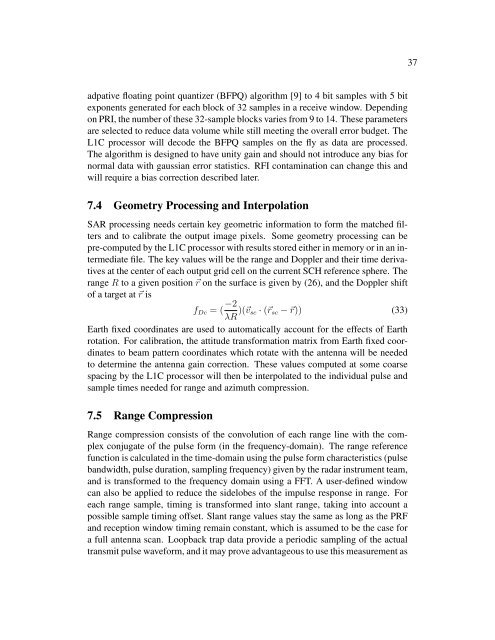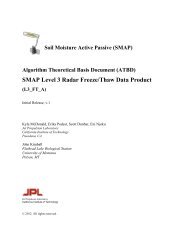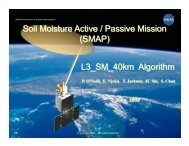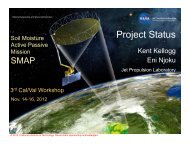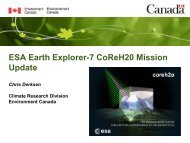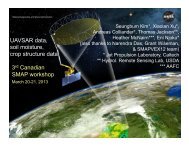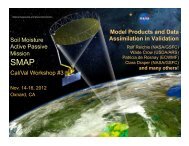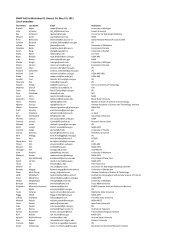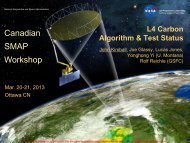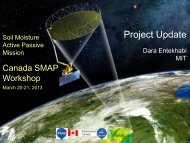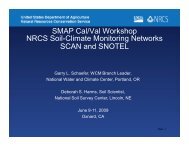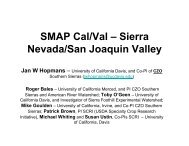(ATBD) SMAP Level 1 Radar Data Products - NASA
(ATBD) SMAP Level 1 Radar Data Products - NASA
(ATBD) SMAP Level 1 Radar Data Products - NASA
You also want an ePaper? Increase the reach of your titles
YUMPU automatically turns print PDFs into web optimized ePapers that Google loves.
37<br />
adpative floating point quantizer (BFPQ) algorithm [9] to 4 bit samples with 5 bit<br />
exponents generated for each block of 32 samples in a receive window. Depending<br />
on PRI, the number of these 32-sample blocks varies from 9 to 14. These parameters<br />
are selected to reduce data volume while still meeting the overall error budget. The<br />
L1C processor will decode the BFPQ samples on the fly as data are processed.<br />
The algorithm is designed to have unity gain and should not introduce any bias for<br />
normal data with gaussian error statistics. RFI contamination can change this and<br />
will require a bias correction described later.<br />
7.4 Geometry Processing and Interpolation<br />
SAR processing needs certain key geometric information to form the matched filters<br />
and to calibrate the output image pixels. Some geometry processing can be<br />
pre-computed by the L1C processor with results stored either in memory or in an intermediate<br />
file. The key values will be the range and Doppler and their time derivatives<br />
at the center of each output grid cell on the current SCH reference sphere. The<br />
range R to a given position ⃗r on the surface is given by (26), and the Doppler shift<br />
of a target at ⃗r is<br />
f Dc = ( −2<br />
λR )(⃗v sc · (⃗r sc − ⃗r)) (33)<br />
Earth fixed coordinates are used to automatically account for the effects of Earth<br />
rotation. For calibration, the attitude transformation matrix from Earth fixed coordinates<br />
to beam pattern coordinates which rotate with the antenna will be needed<br />
to determine the antenna gain correction. These values computed at some coarse<br />
spacing by the L1C processor will then be interpolated to the individual pulse and<br />
sample times needed for range and azimuth compression.<br />
7.5 Range Compression<br />
Range compression consists of the convolution of each range line with the complex<br />
conjugate of the pulse form (in the frequency-domain). The range reference<br />
function is calculated in the time-domain using the pulse form characteristics (pulse<br />
bandwidth, pulse duration, sampling frequency) given by the radar instrument team,<br />
and is transformed to the frequency domain using a FFT. A user-defined window<br />
can also be applied to reduce the sidelobes of the impulse response in range. For<br />
each range sample, timing is transformed into slant range, taking into account a<br />
possible sample timing offset. Slant range values stay the same as long as the PRF<br />
and reception window timing remain constant, which is assumed to be the case for<br />
a full antenna scan. Loopback trap data provide a periodic sampling of the actual<br />
transmit pulse waveform, and it may prove advantageous to use this measurement as


